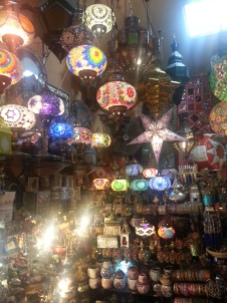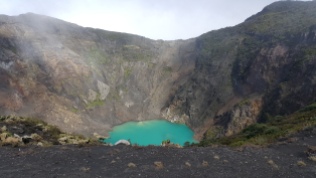(For more information, see my more recent post with details on teaching Guernica in conjunction with Vicente Aleixandre’s poem “Oda a los niños de Madrid muertos por la metralla”, Dec. 2015).
In my (Spanish) Introduction to Textual Analysis course, my students are currently working with two texts in which the aftermath of the Spanish Civil War and the ensuing dictatorship of Francisco Franco form the historical and cultural background: the play Escuadra hacia la muerte (Alfonso Sastre, 1953) and the film El laberinto del fauno (dir. Guillermo del Toro, 2006). As a way of discussing the different ways in which this historical context is relevant to both the play and the film, and to begin thinking about what dramatic and cinematographic effects help communicate this atmosphere to us as readers/viewers, I began our class last week with two paintings, created by Spanish artists during the years of the civil war (1936-39):
Picasso’s famous Guernica (1937):

and Salvador Dalí’s lesser-known España (1938):

I intended to use the images for 10-15 minutes as a way of initiating discussion, so I had not prepared lengthy lectures of these particular pieces before class. My students proved to be not only enthusiastic about sharing their interpretations and thoughts on the paintings, but also far more inquisitive than I had anticipated. For Guernica they hit upon all the major themes and imagery that will prove relevant in our upcoming analytic discussions of Sastre’s play and del Toro’s film: lack of color (black and white, dark grays); the interplay of shadows and light; fragmented and mutilated human bodies; the lack of realism, or the abstract depiction of a historical event (the attack on the town of Guernica); agony; desperation; hopelessness; oppression; death; destruction; chaos. They even noted the “broken” bull – traditionally a symbol of Spain – that, despite the painting’s abstract depiction of war, nevertheless implicates the Spanish nation in particular.
However the class had a more difficult time – initially – comprehending Dalí’s portrayal. This was likely due to the fact that most of them had never seen it before, whereas Guernica, in general, had at least entered their field of vision in some way over the course of their Spanish studies (these students have studied Spanish for at least 4-5 years, on average). Once they were able to perceive the double-image that Dalí created – the ghost-like figure of “Mother Spain” looking down upon the destruction and chaos of a Spanish countryside polluted by the battles of war – they had more questions about the painting’s details. Below is a more detailed depiction of the woman’s face and bust that appear amidst the battlefield in this painting – it is often quite difficult to discern this female figure upon the first viewing of the painting:

In order to (try to) better answer their questions, this weekend I found myself shuffling through my nearly 25 books on Surrealism and Salvador Dalí – remembering why I had once been so passionate about these topics. I also realized that this is still one of my favorite books: Salvador Dalí. The Paintings. by Robert Descharnes and Gilles Néret (Köln: Taschen, 2002). Interestingly, Descharnes and Néret characterize Dalí’s position regarding the Spanish Civil War as apolitical: “True to his principle of taking no interest in politics, … [Dalí] observed [the war] as an entomologist might observe ants of grasshoppers. To him it was natural history; to Picasso, by contrast, it was a political reality. What Guernica was for Picasso, The Burning Giraffe and Soft Construction with Boiled Beans – Premonition of Civil War were for Dalí” (238).

The Burning Giraffe (Jirafa ardiendo) (1937)

Soft Construction with Boiled Beans – Premonition of Civil War (Construcción blanda con judías hervidas – Premonición de la Guerra Civil) (1936)
But for Dalí, the war was indeed a disturbing reality he could not ignore – his close friend, the poet and playwright Federico García Lorca, was murdered at the hands of the Nationalist militia in 1936. And while Dalí’s paintings may not appear to exhibit the same overt social commentary that is clearly visible in Picasso’s Guernica, I would disagree with Descharnes and Néret that the works themselves are apolitical. If we re-examine them, for example, in light of the aforementioned themes my class pointed out in Guernica, we find many – if not all – of the same techniques and representations. The surrealist style, bold colors, and unconventional imagery (and titles!) may mask the precise political and cultural realities, but we must not trivialize the way in which they nevertheless reveal the extent to which the death and destruction of this particular war affected even the most flippant, avant-garde, and typically irreverent of Spanish citizens.
I’ll end here by using this post as yet another platform from which I can share a few of my favorites of Dalí’s double-image paintings. After having read about and studied them for so many years, even traveling to remote Spanish villages to see the originals, I often forget how new and remarkable these paintings can be to others who are discovering them for the first time – especially when these “others” were all born after 1993…! I was amazed, for example, that many of my students had never seen what is arguably one of Dalí’s most popular double-image paintings, Swans Reflecting Elephants:

Swans Reflecting Elephants (Cisnes que se reflejan elefantes) (1937)

Ballerina in a Death’s Head (Bailarina en una calavera) (1939)

Slave Market with the Disappearing Bust of Voltaire (Mercado de esclavos con la aparicion del busto invisible de Voltaire) (1940)
What have you recently taught or shared with your class that you were surprised to find out was entirely new to them?















Pingback: Salvador Dalí’s Christmas Cards Are Better than Yours | Rebecca M. Bender, PhD
Pingback: Exploring Female Identities in Carmen de Burgos’ “La rampa” | Rebecca M. Bender, PhD
Pingback: The Dalí Triangle: A Surrealist’s Take on the Catalonian Landscape | Rebecca M. Bender, PhD
Pingback: Picasso on Maternity and Motherhood | Rebecca M. Bender, PhD
Pingback: The Morphing Body: Salvador Dalí’s Skulls and the Female Form | Rebecca M. Bender, PhD
Hi, would be great if you got back to me as I am doing my dissertation on this topic and it seems as you are well read on the subject.
Hope to hear from you
Hello! I missed this comment before – what themes and works are you working with? i’m not sure how i might be able to help, but if you want to email me with a few details I’d be happy to think about what might be useful to you – here is my work email – benderre@grinnell.edu
Pingback: La Llorona: Incorporating Latino Studies into Hispanic Literature | Rebecca M. Bender, PhD
Pingback: Posters and Propaganda from the Spanish Civil War (1936-39) | Rebecca M. Bender, PhD
Pingback: Artist Salvador Dali at Port Lligat, Girona, Spain | Oaxaca Cultural Navigator : Norma Hawthorne Shafer
This website was… how do I say it? Relevant!!
Finally I’ve found something which helped me. Thank you!
Wonderful, I’m glad you enjoyed it!
Pingback: Picasso’s “Guernica” and Aleixandre’s “Oda”: The Spanish Civil War in Art and Poetry | Rebecca M. Bender, PhD
Pingback: Food, Art, and Eroticism? Gala’s Meals in Salvador Dalí’s Cookbook | Rebecca M. Bender, PhD
Pingback: Make Good Art – My Blog
I have a Spanish civil war painting Thais signed with a forward and backward B within a square and dated 1937. Would you know who that artist might be.
Hmm, no, I don’t – but I’ll keep in in mind in case I’d come across anything! Good luck!
I have an original painting or lithograph of soldier in the Spanish civil war signed by “Simi”. Do you know who the artist is and does it have any value.
Sorry, I don’t know who that could be. If you find out, let me know 🙂 Good luck!
Pingback: Make Good Art | Muddy Colors